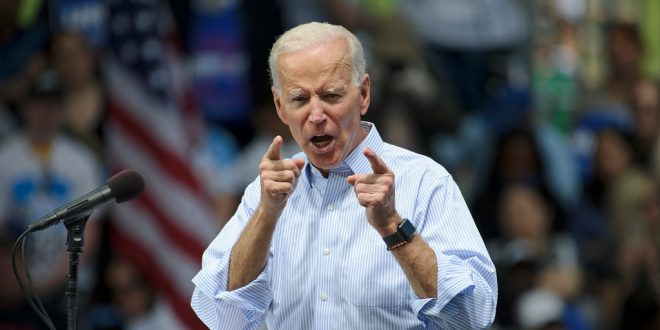US President Joe Biden plotted inflation-fighting strategy, on Tuesday, during his meeting with the Fed Chair Jerome Powell. Biden reportedly focused on relentlessly surging prices, with the destiny of the US economy and his own political prospects increasingly dependent on the actions of the government’s central bank.
Tuesday’s meeting was the first since Powell was renominated in November by Biden to lead the central bank and came two weeks after his confirmation for a second term by the Senate.
Biden hopes to demonstrate to voters that he can accommodate their accelerated concerns and worries about higher fuel prices as well as the surging cost of grocery. Biden also reiterated that he insists that Fed will act independently and to remain entirely free from any political pressure.
Like Biden, the Fed wants to get inflation under control without serving a severe blow to the country’s economy or dragging markets down recession slope, this is a highly sensitive mission that includes interest rate hikes this summer. Biden said he would not attempt to direct that course as some former presidents have tried.
“My plan to address inflation starts with simple proposition: Respect the Fed, respect the Fed’s independence,” Biden said.
The meeting was Biden’s recent endeavour to exhibit his dedication to containing the 8.3% leap in consumer prices over 2021. Surging fuel and food costs have angered many Americans heading into the midterm elections, putting Democrats’ control of the House and Senate at risk.
It also represented something of a reversal by Biden as inflation weighs heavily on voters’ minds. Biden asserted in April 2021 that he was “very fastidious about not talking” with the independent Fed and wanted to avoid being seen as “telling them what they should and shouldn’t do.”
The White House, along with the Fed, initially portrayed the inflation surge as a temporary side effect caused by supply chain issues as America emerged from the pandemic. Republican lawmakers were fast to criticize Biden’s $1.9 trillion coronavirus relief package from last year as pumping too much money into the economy and causing more inflation.
Inflation has shown signs of moderating but is likely to remain far above the Fed’s 2% target through the end of this year. Fuel prices are expected to keep surging, particularly now that the European Union has agreed to cut off 90% of its oil purchases from Russia. That will force the EU to buy more oil from elsewhere, and it drove oil prices to $115 a barrel Tuesday.
This was only the fourth meeting between Biden and the Federal Reserve chair, though Powell breakfasts as often as once a week with Treasury Secretary Janet Yellen, who also attended Tuesday’s meeting along with Brian Deese, the White House National Economic Council director.
Ahead of the meeting, Biden suggested that he and Powell were aligned on addressing inflation.
“My predecessor demeaned the Fed, and past presidents have sought to influence its decisions inappropriately during periods of elevated inflation,” Biden said in an op-ed posted Monday by The Wall Street Journal.. “I won’t do this. I have appointed highly qualified people from both parties to lead that institution. I agree with their assessment that fighting inflation is our top economic challenge right now.” On the contrary, former US President Donald Trump repeatedly attacked Powell after the Fed chair oversaw moderate interest rate hikes in 2018 and continued his public criticism even as Powell cut rates in 2019.
Biden’s endorsement of the Fed’s policies now grants Powell important political cover for a series of sharp interest rate hikes intended to contain higher prices. The higher rates could cause layoffs, raise the unemployment rate and even tip the economy into recession.
Amid ascending concerns that the American economy may repeat the high, persistent inflation of the 1970s, the cooperation between Biden and Powell represents a crucial difference from that time and could make it easier for the Fed to restrain higher prices. In the early 1970s, President Richard Nixon pressured Fed chair Arthur Burns to lower interest rates to spur the economy before Nixon’s 1972 reelection campaign. Nixon’s interference is now widely seen as a key contributor to runaway inflation, which remained high until the early 1980s.
Biden faces an increasingly global challenge as energy and food costs have jumped after the war began in Ukraine in February. China imposed lockdowns tied to coronavirus outbreaks that further strained supply chains. This has left the European Union nursing record inflation and the risks of a recession, while American consumers are increasingly discontented by fuel prices averaging a nominal record of $4.62 a gallon.
Powell pledged to keep intensifying the Fed’s key short-term interest rate to cool the economy until inflation is “coming down in a clear and convincing way.” But those rate hikes have spurred fears that the Fed, in its drive to slow borrowing and spending, may push the economy into recession.
Biden also indicated that the record-setting pace of job creation in the aftermath of the pandemic would slow dramatically, suggesting more moderate levels of 150,000 jobs per month from 500,000. That, he said, would be no warning of weakness but “a sign that we are successfully moving into the next phase of recovery—as this kind of job growth is consistent with a low unemployment rate and a healthy economy.”
Biden’s previous efforts, such as oil releases from the strategic reserve, improving port operations and calls to investigate price gouging, were not capable of achieving any satisfactory results. High prices have undermined his efforts to highlight the low 3.6% unemployment rate, leaving a growing sense of pessimism among Americans.

 Noor Trends News, Technical Analysis, Educational Tools and Recommendations
Noor Trends News, Technical Analysis, Educational Tools and Recommendations




